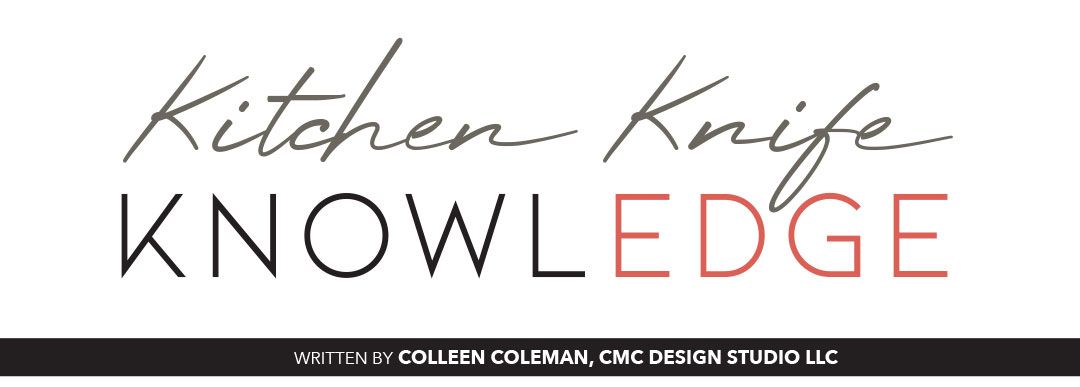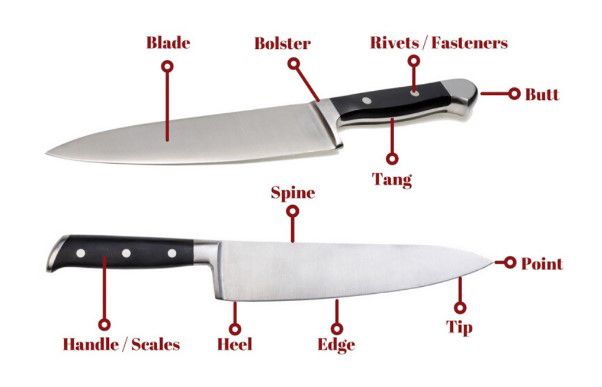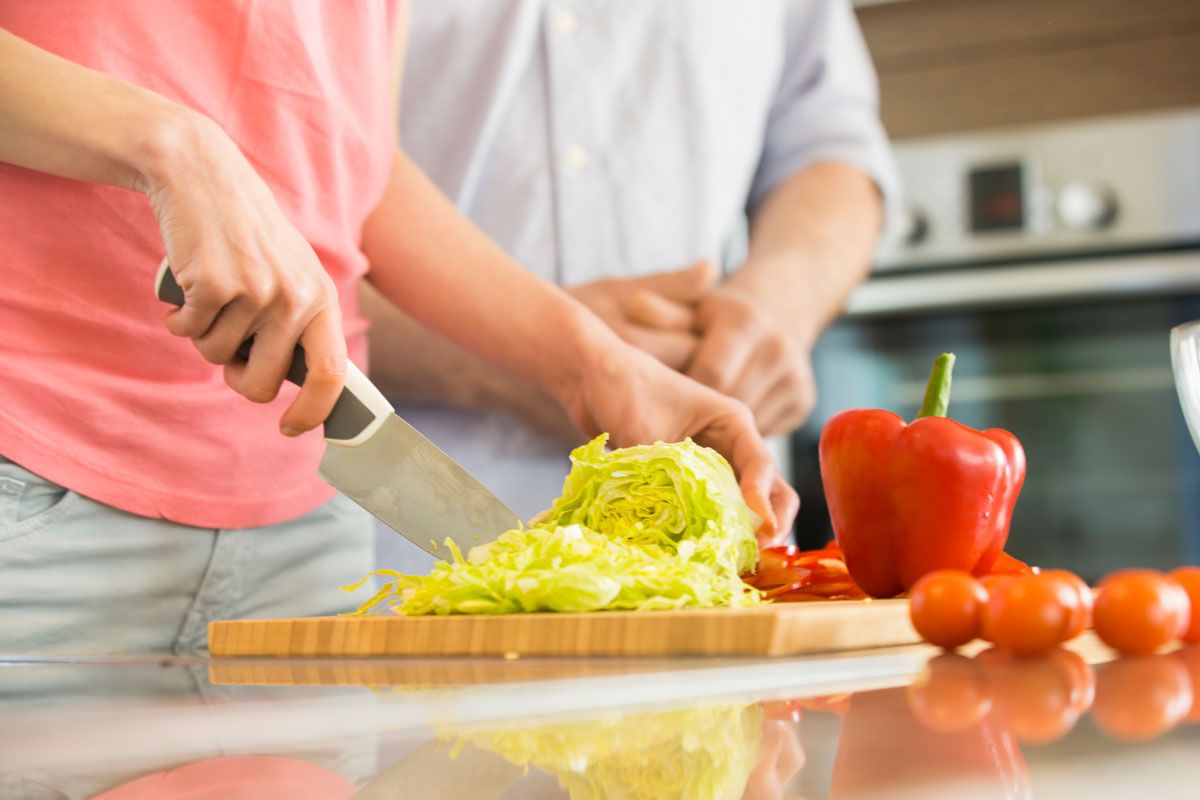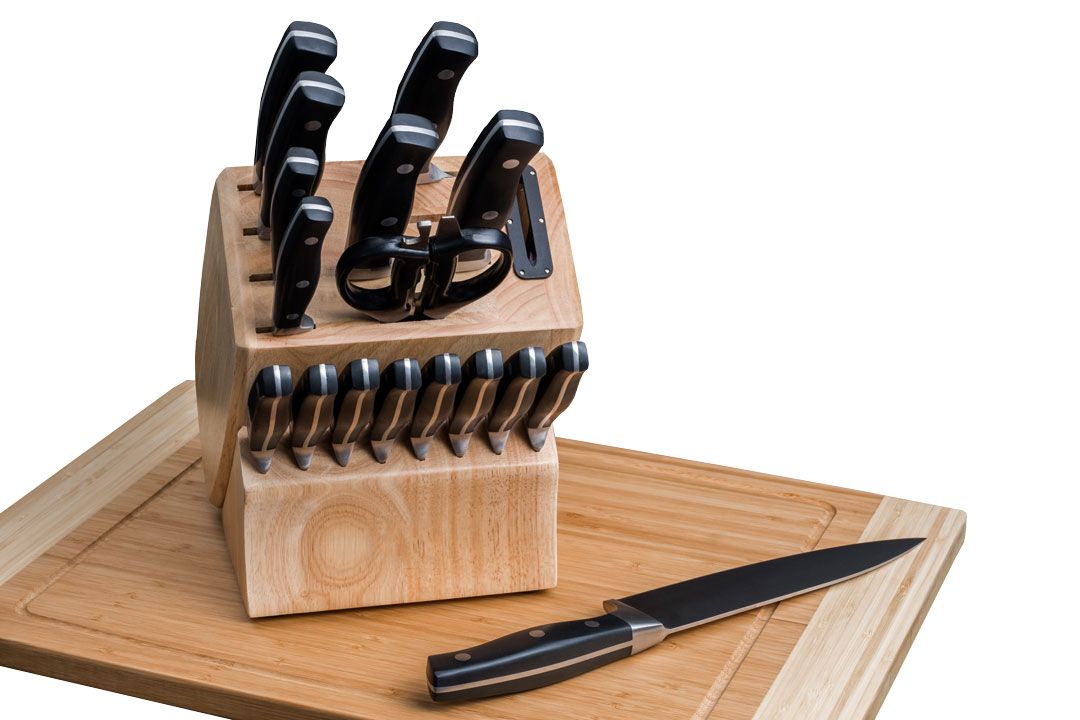
I have been in many kitchens; small to quite large. A typical item I see in most is the standard butcher block of knives.
And then it hit me…
”Do we really know why we have these knives and what their true purpose is? Or do we just grab what seems like the go-to option we’ve become used to cutting with?”

Before I get started, I asked John to help me understand the parts of the knife and how to choose one that is made well, easy to use and won’t irritate my hand or wrist as I prepare meals. Forged knives (whether by hand or machine) have a single bar of steel. John stated, “They’re heavier than their stamped counterpart, making it well balanced, and can even assist in the cutting process which reduces joint stress.” So, how do you tell the difference? John replied, “Look at this knife diagram…in most cases, a forged knife will have a Bolster, the top thicker metal portion joining the handle and the blade adding to the weight but creating more balance in the center of the knife.” This is typically where a cook will grip a knife between their thumb and forefinger. Forged knives will most always have a Tang, the portion of the blade that extends into the handle, offering stability and extra weight. To choose a knife best for you, John recommends that you actually hold the knife and feel if the weight is balanced while using it. With all that said…let’s get ourselves familiar with some specific knife knowledge!

(left: Classic Chef Knife by Shun with hammered tsuchime finish)
So, what are the best four knives to have in your kitchen and why? Let’s start with the Chef’s Knife, otherwise known as the Cook’s Knife. It comes in several sizes ranging from six to ten inches. This knife is the “all-arounder for both professional and hobby chefs alike” states John. As the main workhorse of the kitchen, it can be used to chop herbs, cut vegetables and then transition to slicing and dicing fish and meats as well. The curved blade also allows for a smooth, easy rocking motion for food preparation! This is a must-have in all kitchens!

(left: Classic Pairing Knife)
A Paring Knife, with its straight double bevel edge, is another essential and usually comes in sizes ranging from three to four inches. “Paring” essentially means to peel or trim off the outer skin of a fruit or vegetable such as an apple or tomato. These knives can also be used for cleaning, coring, trimming and slicing smaller items.

(left: Santoku Knife with Granton Edge)
The Santoku Hollow Edge knife is the “Most fun knife in your block!,” stated John. “It’s sharper than your average knife. “With its granton edge, it creates less ‘drag’ with air pockets holding cut slices, such as cucumbers, to your knife blade” relayed John. Okay, I’m game, what’s a “granton edge?” …I had to ask too! It’s the tiny pockets along the edge of the knife that reduce the drag of sliced or chopped food from clinging to the knife. This happens all the time when I slice potatoes. But no fear, pick one up and you’ll slice, dice and mince like a pro!


I have been in many kitchens; small to quite large. A typical item I see in most is the standard butcher block of knives.
And then it hit me…
”Do we really know why we have these knives and what their true purpose is? Or do we just grab what seems like the go-to option we’ve become used to cutting with?”
Well, today, I want to give you a guide to those knives and many more with the help of John Reardon, owner of Compliments to the Chef located on Railroad Ave in Saratoga Springs.
Before I get started, I asked John to help me understand the parts of the knife and how to choose one that is made well, easy to use and won’t irritate my hand or wrist as I prepare meals. Forged knives (whether by hand or machine) have a single bar of steel. John stated, “They’re heavier than their stamped counterpart, making it well balanced, and can even assist in the cutting process which reduces joint stress.” So, how do you tell the difference? John replied, “Look at this knife diagram…in most cases, a forged knife will have a Bolster, the top thicker metal portion joining the handle and the blade adding to the weight but creating more balance in the center of the knife.” This is typically where a cook will grip a knife between their thumb and forefinger. Forged knives will most always have a Tang, the portion of the blade that extends into the handle, offering stability and extra weight. To choose a knife best for you, John recommends that you actually hold the knife and feel if the weight is balanced while using it. With all that said…let’s get ourselves familiar with some specific knife knowledge!
So, what are the best four knives to have in your kitchen and why? Let’s start with the Chef’s Knife, otherwise known as the Cook’s Knife. It comes in several sizes ranging from six to ten inches. This knife is the “all-arounder for both professional and hobby chefs alike” states John. As the main workhorse of the kitchen, it can be used to chop herbs, cut vegetables and then transition to slicing and dicing fish and meats as well. The curved blade also allows for a smooth, easy rocking motion for food preparation! This is a must-have in all kitchens!
A Paring Knife, with its straight double bevel edge, is another essential and usually comes in sizes ranging from three to four inches. “Paring” essentially means to peel or trim off the outer skin of a fruit or vegetable such as an apple or tomato. These knives can also be used for cleaning, coring, trimming and slicing smaller items.
The Santoku Hollow Edge knife is the “Most fun knife in your block!,” stated John. “It’s sharper than your average knife. “With its granton edge, it creates less ‘drag’ with air pockets holding cut slices, such as cucumbers, to your knife blade” relayed John. Okay, I’m game, what’s a “granton edge?” …I had to ask too! It’s the tiny pockets along the edge of the knife that reduce the drag of sliced or chopped food from clinging to the knife. This happens all the time when I slice potatoes. But no fear, pick one up and you’ll slice, dice and mince like a pro!
Oh, the inevitable Bread Knife. We all love bread, whether homemade or bought in a loaf from a bakery. But, beware, you want to ensure you don’t use an inferior knife that will tear your loaf instead of slicing it neatly. These knives come in lengths between eight and ten inches and can be used to cut other soft items with a tough skin or crust. The big NO-NO…never use on fish or meats as the scalloped edge will not produce an even slice. Likewise, this particular knife does not require the need for a Steel, or what we consider the sharpener. You see, the serrated edge could be damaged with attempts to keep this knife honed. In most cases, these knives should remain sharp for up to 5 years before being professionally sharpened.
Speaking of the Steel (sharpener), all the other knives should be lightly honed (not aggressively sharpened) before each use. John recommends, “To do this properly, hold the steel upright on a firm, slip free surface. Align the beveled edge of the knife with the steel and pull back gently, alternating from side-to-side about four to six times.”
Now, I want to emphasize that the best place to use your knives is on a cutting board or butcher block, not your stone countertop where you could damage the blade of your knife. Besides, did you know that your wood block is naturally antimicrobial? Yes, you read that correctly! “99.9% of bacteria placed on a wooden chopping board begins to die completely within minutes.” This is proven research by the scientists at the University of Wisconsin. Wood allows liquid to dry, preventing growth of bacteria, unlike the plastic counterpart which only retains water. Easy clean up can be achieved with a kitchen scraper…and NO soap, just rub half a lemon over the surface if necessary. Finish with Butcher Block Oil to keep your wood regularly seasoned for proper maintenance, And NEVER put your wood board into the dishwasher, nor any of your cooking knives. These should all be washed by hand. Likewise for knife storage, a wooden block or even magnetic strips are your best options. And you know where to find all these goodies and more, right? Compliments to the Chef... Just ask John Reardon where to find it in his shop! Happy cooking everyone!
Until next time my friends,
